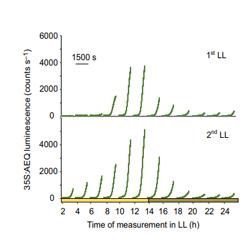Supervisor
Professor Alex Webb
Brief Summary
Life on a rotating planet means that there are times of day when it is advantageous to respond to extracellular stimulation, and times when a less of a response might have advantage. For example, we discovered that plants are more sensitive to cold during the day than at night. This makes sense because it usually gets cold at night, but cold during the day indicates winter is coming. We want to use this daily modulation of signalling as a tool to identify new pathways by which the circadian clock regulates plant physiology.
Importance of Research
Circadian clocks regulate nearly every aspect of plant biology, though we do not often know how or why. One of the great mysteries is how the cycles of oscillations of the transcription factors that make up the circadian clock are converted in to physiological responses. This project investigates the basic biology of circadian regulation, and aims to identify under discovered pathways. The goal is to make a breakthrough in basic biology.
Project Summary
To identify the basic pathways by which the circadian oscillator regulates signalling we will use chemical library screening, single cell sequencing and predictive bioinformatics to identify the mechanisms by which plants respond appropriately to stress signals for the time-of-day. Plants will be treated with cold or light signals at different times of day to induce increases in cytosolic-free calcium, which we will measure using a bioluminescent protein aequorin. Cold causes largest increases in cytosolic-free calcium during the day, whereas dark causes the largest increases at dusk. We aim to identify chemicals that are inhibitors of the circadian regulation of stimulus-induced increases in calcium. The nature of the identified chemicals will indicate the biological pathways that regulate the circadian modulation of signalling. The newly identified pathways will be investigated further by performing biochemistry to find the binding partners and studies in mutant lines.
What will the successful application do?
The student will screen a chemical library for effects on circadian modulation of stimulus-induced increases in cytosolic calcium. The student will use a range of approaches including proteomics, transcriptomics and mutant analyses to investigate the mechanism of action of the identified chemical. The approaches will depend on the nature of the identified chemical.
Training Provided
The student will receive training in circadian biology, calcium signalling, image analysis, molecular genetics, transcriptiomics or proteomics.

